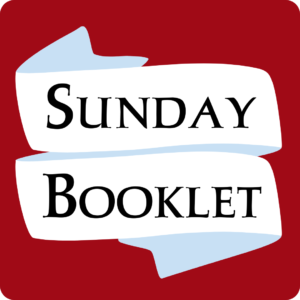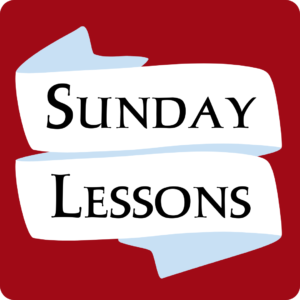Worship Guide for May 4, 2025
Like TV Guide, but from God! Find the text of the Prayers of the People and Sermon below. Use the buttons provided to find other worship materials.
To see the Worship Guide for other weeks, click here.
To see the Book of Common Prayer online, click here.
Prayers
Weekly Prayer List Recording:
Prayers of the People:
Easter 3
The response to the bidding, “Lord of new possibilities,” is “hear us”
Lord in time and space –In the time in between the resurrection of Jesus as the Christ and the general restoration of the entire creation we wait with patience for the hope that is within us to become a force for good in a world increasingly deaf to the values and expectations of your kingdom. Lord of new possibilities, hear us.
We pray for the Church and her life: for Sean, the Presiding Bishop, and Nicholas, our bishop; for Hosam, the Archbishop of Jerusalem; for Roman Catholic leaders meeting in Papal Conclave this week; for Bartholomew, the Ecumenical Patriarch, and other Christian leaders. Lord of new possibilities, hear us.
We pray for the world and its pressing needs: Distressed by the changed direction in American foreign policy, we continue to pray for the coming of peace with justice in the Middle East, remembering especially Palestinian communities now subject to the violence of ethnic cleansing.
We continue to pray for a negotiated peace in Ukraine that honors a commitment to Ukrainian sovereignty and future self-determination.
For the people of Sudan, Yemen, and Myanmar, for all forced to flee from their homes and homelands by poverty, violence, and war.
We remember communities worldwide adversely affected by the Administration’s cancellation of vital health and social development aid funding. Lord of new possibilities, hear us.
We pray for the nation, mindful of so many concerns at this time:
The congregation is invited to bring your concerns for our country to the Lord, either silently or aloud.
Lord, we ask you to bless the Congress and the courts in upholding the integrity of the Constitution. Lord of new possibilities, hear us.
We remember the earth, our increasingly fragile island home. We pray for a strengthening of emergency services and necessary infrastructure to meet the challenge of climate instability. Lord of new possibilities, hear us.
We pray for all in need and in any trouble: for those whose strength is failing through ill health; whose spirits are flagging through depression; whose determination is being sapped through addiction; that they might know our comforting presence, and your healing. Lord of new possibilities, hear us.
We remember with love those who have asked for our solidarity in prayer: Mary, Sam, Benjamin, Hugh, Connie, Jerry, and others we name. Lord of new possibilities, hear us.
We pray for our own needs, together with those nearest and dearest to us, remembering especially those celebrating birthdays this week: Marshall Carpenter, who is currently walking the Camino de Santiago, and Arthur Edgar. And we give thanks for the birth of Thomas James Leary, son of Lydia and Matt Leary, on April 29. Lord of new possibilities, hear us.
Rejoicing in the fellowship of so great a cloud of witnesses, we remember those who have recently died, and others we love but see no longer, especially those we name. We remember everyone coming to terms with the loss of a loved one.
Lord of new possibilities, hear us.
Celebrant adds a concluding prayer.
Sermon
The Eyes of the Heart
The Reverend Linda Mackie Griggs
Third Sunday of Easteer
Year C
John 21:1-19
Sermon Recording:
“Simon son of John, do you love me?”
Resurrection is not a happy ending.
(A colleague has dared me just to leave this here and sit down. For better or worse, I shall continue…)
The joy and beauty of Easter Sunday conditions us to view the post-Resurrection stories through a soft lens. Once Jesus emerges from the tomb, the hard part is over, right? Death is conquered, and it only remains for the disciples to recognize their friend in a series of encounters that often leave us smiling, at least just a little bit. Mary Magdalene thinks Jesus is the gardener—can you imagine him in overalls and a floppy hat? The pair on the road to Emmaus exclaim to one another, “I knew it was him!”, though we know they had been completely clueless until Jesus broke bread with them. Even Thomas has become a figure viewed with a degree of bemusement; my daughter calls him the Ultimate Fact Checker. And today we have Jesus on the beach. Making breakfast. A charming scene.
No matter where we are on our Easter journey—whether we’re ready for the triumphant brass or even if we struggle to be ready for Easter joy, as K observed in last week’s sermon—we do find a measure of comfort in these narratives; familiarity with the old stories, enjoyment of the vividness of the encounters, the touch of humor. Who doesn’t want to bask for a moment in the warmth of a happy ending?
But while uncritical first readings may be a comfortable introduction to the meaning of the Resurrection, for our own spiritual well-being we can’t stay there, any more than Jesus could stay in the Tomb. He must emerge into Risen Life, and so must we. We need the “yes, and” — to sharpen the soft focus of our perspective and to look deeply and honestly at Resurrection’s claim on our lives.
Resurrection is not a happy ending; it is only the beginning, and we are challenged to take it very seriously.
First, let’s take a quick look at the four Gospels’ endings. They are distinct from one another, as we would expect, with each storyteller writing from a particular historical context and to a particular audience. Author Peter Choi observes that the Resurrection is too momentous to submit to a single perspective, or even to any attempt to chronologize the events of its aftermath, so he asks us to view all of the post-Resurrection narratives in conversation with one another; revealing what he calls a “multivocal call of resurrection spirituality” that speaks to us in the often complex tension of where we are in our lives. In Matthew’s Gospel Jesus called his disciples to “Go”—a Great Commission to go out into the world, spreading the Good News and gathering new faithful into the community. By contrast, Luke’s Jesus instructed the disciples to “Stay”—to stay in Jerusalem to await the coming of the Spirit; perhaps against their first inclination to flee the authorities. It can be hard to stay when leaving would be easier—and safer. In Mark’s Gospel, the first and shorter ending shows disciples fleeing the tomb in fear and telling no one—which validates the sometimes overwhelming nature of Resurrection—and the need for time to process and ponder. And finally, in John’s Gospel, Jesus says simply, “Follow me.” For some, these are comforting words. For others, it is a challenge. Yes, and.
“Go”, “Stay,” Ponder, “Follow.” Resurrection calls us into a tapestry of all of these invitations; woven, entwined, entangled…and inescapable.
“Simon son of John, do you love me?”
If Simon Peter were to be defined by, and named for, his worst act, he would be called Peter the Denier. If what remains for the disciples from Good Friday is the trauma of Jesus’ crucifixion, what remains for Peter is compounded by his threefold denial of Jesus on Maundy Thursday. He lives with deep, deep, guilt and shame, and even in the immediate aftermath of Jesus’ return, the community has surely not forgotten what happened around that charcoal fire outside the High Priest’s house— “I don’t know him…I don’t know him…I don’t know him.”
This is probably why today’s story was added to John’s Gospel later by someone in the Johannine community, in order to provides some closure to Peter’s story. So the storyteller returns us to a charcoal fire, this time on the beach rather than a shadowy nighttime courtyard. And this time the interrogator is Jesus himself.
“Simon son of John, do you love me?”
We can imagine Peter in this piercing moment, metaphorically as naked before Jesus as he was while still on the fishing boat:
“Yes, Lord, you know that I love you…Yes…Yes…”
A while ago my spiritual director gave me an assignment. She wanted me to ask in my prayer time, “Jesus, how do you see me?”
Talk about feeling vulnerable. Talk about being face to face with Jesus and pondering Every. Single. Way. in which I don’t measure up; every single time my actions or words have denied my love for him. How must Jesus see me?
But I’ve twisted the question from the original, haven’t I? The question was “Jesus, how to you see me?” not “Jesus, how do you judge me?” (That is for another sermon.) It’s a struggle to hear above the noise of failure and falling short, isn’t it?
How does Jesus see us?
Through the eyes of his heart.
Good News, indeed.
Could Peter hear Jesus’ love above the cacophony of his failure?
“Feed my lambs…Tend my sheep…Feed my sheep.”
Seeing through the eyes of his heart, Jesus challenges Peter to do the same as he passes the mantle of the Good Shepherd who lays down his life for the sheep to one who Jesus knows loves him deeply, if imperfectly, and who can be entrusted with the work of realizing the Dream of God. And Jesus makes clear that this is not without risk.
“’But when you grow old, you will stretch out your hands, and someone else will fasten a belt around you and take you where you do not wish to go.’ (He said this to indicate the kind of death by which he would glorify God.) After this he said to him, ‘Follow me.’”
“Follow me.”
Jesus’ invitation and challenge to Peter put Peter face to face with his own mortality, and it does the same with us. We may not share Peter’s violent end, but our work as the People of Resurrection calls us to turn our lives over to the unfolding of the Dream of God. We are called to proclaim in our lives that Resurrection is not just an event; it is a process of turning the world right-side up by turning it upside down; of living into the knowledge that, as K said last week, “Death will attempt to crush our faith, and God will keep resurrecting life.” Again, and again, and again.
I believe that deep down, in spite of our desire–like Peter and the disciples going back to fishing—in spite of our initial desire to go back to the old routine of our pre-Easter lives—I believe that we yearn for more, just as Peter yearned for reconciliation and forgiveness, leaping out of the boat to swim to Jesus on the beach. We yearn to respond to the Gospels’ calls to a Resurrection spirituality that meets us where we are and invites us into something new—to see, and to be seen, through the eyes of the heart of Jesus.
Brian McLaren expressed this yearning really well in his book, Why Did Jesus, Moses, the Buddha, and Mohammed Cross the Road?
“What might happen if every Easter we celebrated the resurrection…as the ongoing resurrection of all humanity through Christ?… our ongoing resurrection from violence to peace, from fear to faith, from hostility to love, from a culture of consumption to a culture of stewardship and generosity…. What if our celebration of Easter was so radical in its meaning that it tempted tyrants … everywhere to make it illegal, because it represents the ultimate scandal: an annual call for creative and peaceful insurrection against all status quos based on fear, hostility, exclusion, and violence? … [He wrote this in 2012, by the way]… What if Easter was about our ongoing resurrection “in Christ”—in a new humanity marked by a strong-benevolent identity as Christ-embodying peacemakers, enemy lovers, offense forgivers, boundary crossers, and movement builders? … How might the world be changed because of it?”
May this be our beginning. Alleluia and Amen.




